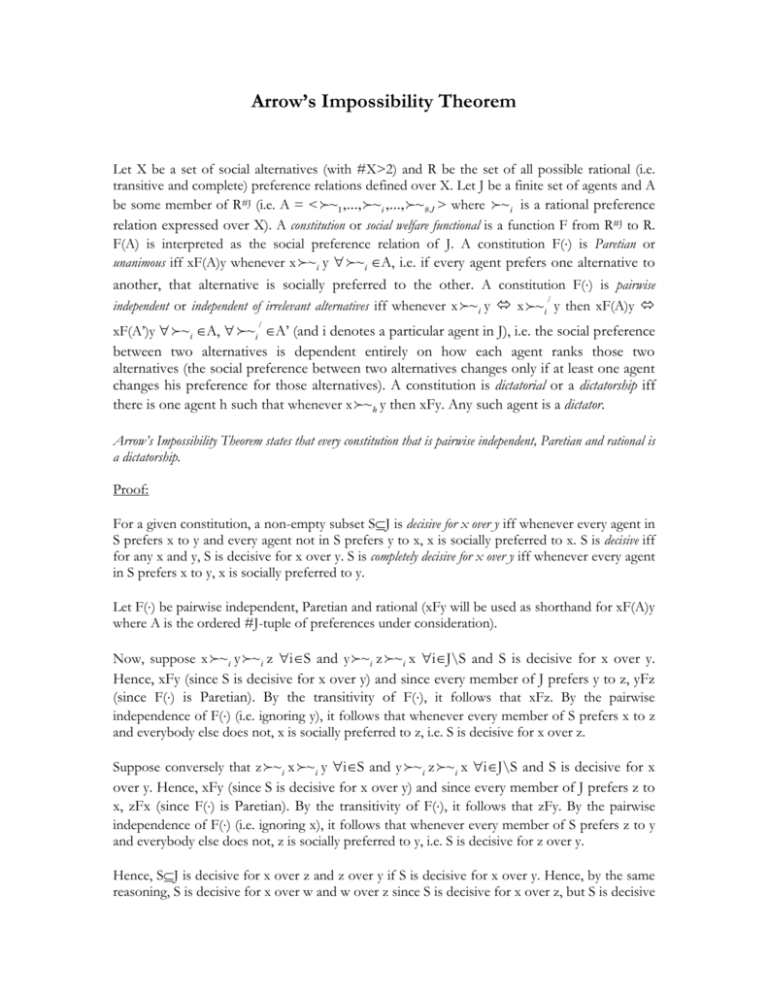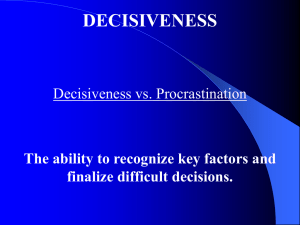Arrow`s Impossibility Theorem
advertisement

Arrow’s Impossibility Theorem
Let X be a set of social alternatives (with #X>2) and R be the set of all possible rational (i.e.
transitive and complete) preference relations defined over X. Let J be a finite set of agents and A
be some member of R#J (i.e. A = < ~1 ,..., ~ i ,..., ~ # J > where ~ i is a rational preference
relation expressed over X). A constitution or social welfare functional is a function F from R#J to R.
F(A) is interpreted as the social preference relation of J. A constitution F() is Paretian or
unanimous iff xF(A)y whenever x ~ i y ~ i A, i.e. if every agent prefers one alternative to
another, that alternative is socially preferred to the other. A constitution F() is pairwise
/
independent or independent of irrelevant alternatives iff whenever x ~ i y x ~ i y then xF(A)y
xF(A’)y ~ i A, ~ i A’ (and i denotes a particular agent in J), i.e. the social preference
between two alternatives is dependent entirely on how each agent ranks those two
alternatives (the social preference between two alternatives changes only if at least one agent
changes his preference for those alternatives). A constitution is dictatorial or a dictatorship iff
there is one agent h such that whenever x ~ h y then xFy. Any such agent is a dictator.
/
Arrow’s Impossibility Theorem states that every constitution that is pairwise independent, Paretian and rational is
a dictatorship.
Proof:
For a given constitution, a non-empty subset SJ is decisive for x over y iff whenever every agent in
S prefers x to y and every agent not in S prefers y to x, x is socially preferred to x. S is decisive iff
for any x and y, S is decisive for x over y. S is completely decisive for x over y iff whenever every agent
in S prefers x to y, x is socially preferred to y.
Let F() be pairwise independent, Paretian and rational (xFy will be used as shorthand for xF(A)y
where A is the ordered #J-tuple of preferences under consideration).
Now, suppose x ~ i y ~ i z iS and y ~ i z ~ i x iJ\S and S is decisive for x over y.
Hence, xFy (since S is decisive for x over y) and since every member of J prefers y to z, yFz
(since F() is Paretian). By the transitivity of F(), it follows that xFz. By the pairwise
independence of F() (i.e. ignoring y), it follows that whenever every member of S prefers x to z
and everybody else does not, x is socially preferred to z, i.e. S is decisive for x over z.
Suppose conversely that z ~ i x ~ i y iS and y ~ i z ~ i x iJ\S and S is decisive for x
over y. Hence, xFy (since S is decisive for x over y) and since every member of J prefers z to
x, zFx (since F() is Paretian). By the transitivity of F(), it follows that zFy. By the pairwise
independence of F() (i.e. ignoring x), it follows that whenever every member of S prefers z to y
and everybody else does not, z is socially preferred to y, i.e. S is decisive for z over y.
Hence, SJ is decisive for x over z and z over y if S is decisive for x over y. Hence, by the same
reasoning, S is decisive for x over w and w over z since S is decisive for x over z, but S is decisive
for z over w and w over y since S is decisive for z over y, i.e. S is decisive. Therefore if S is
decisive for some x over y, S is decisive.
For decisive SJ and TJ, let:
z ~ i y ~ i x iS\(ST);
x ~ i z ~ i y i(ST);
y ~ i x ~ i z iT\(ST);
y ~ i z ~ i x iJ\(ST).
Now, S is decisive and z ~ i y iS so zFy. Similarly, xFz because T is decisive and x ~ i z
iS. By transitivity, xFy and hence, by pairwise independence, ST is decisive for x over y and
therefore decisive.
Suppose x ~ i z ~ i y iVJ and y ~ i x ~ i z iJ\V. If xFy then, by pairwise
independence, V is decisive for x over y and hence decisive. If yFx then, because xFz by the
Paretian condition, yFz by transitivity and thus, by pairwise independence, J\V is decisive.
Therefore, for any proper subset of J, either it or its complement is decisive.
Note that the empty set cannot be decisive because then it could be that every agent had a
preference for x over y, but yFx, violating the Paretian condition. Therefore, if some subset S of
J is decisive and S is a subset of T, T is decisive; for otherwise, J\T would be decisive and so
S(J\T)= would be decisive, but this cannot be the case as noted.
If SJ and #S>1 then there is a proper non-empty subset of S, S’ (S’S). Either S’ or J\S’ is
decisive. If J\S’ is decisive then (J\S’)S=S\S’ is decisive. Otherwise S’ is decisive. Hence any
decisive set contains a decisive proper subset.
It follows that there is a singleton subset of J that is decisive. Assume this is not the case and no
singleton set is decisive. It follows that no set with precisely two members is decisive, for a nonempty proper subset of it would have to be decisive otherwise and any non-empty proper subset
of a set with precisely two members is a singleton set. In general, if set K is not decisive, set K;h
is not decisive since either K or K;h\K={h} would have to be decisive and by hypothesis
neither is. By induction (since J is finite), J cannot be decisive. But J is decisive by the Paretian
condition. It follows reduction ad absurdum that there exists a decisive singleton subset of J.
If S is decisive then for some x, yX, S is completely decisive for x over y: suppose there for
some x and y every member of S prefers x to y, but some agents not in S prefer y to x and some
prefer x to y. Let the set of those not in S who prefer x to y be T. S ST and so ST is
decisive and a fortiori ST is decisive for x over y and therefore xFy. Therefore S is completely
decisive for x over y (in the extreme case where T=, this follows straightaway from S being
decisive; in the extreme case where T=J\S, this follows from the Paretian condition).
It follows hence that there is singleton subset of J, {h}, which is decisive and hence completely
decisive. Thus whenever x ~ h y then xFy, i.e. F() is a dictatorship■
How does Arrow’s theorem relate to the Condorcet paradox?
Arrow’s theorem states that any method of social decision making (over at least three
alternatives) is a dictatorship (i.e. there is one agent whose preferences prevail as the preferences
of society) if it satisfies the following criteria: pairwise independence (i.e. the ranking of one
alternative should not affect the relative ranking of two different alternatives), rationality (i.e.
transitivity: for every alternative x, y and z, if x is ranked higher than y and y is ranked higher
than z, x is ranked higher than z; completeness: for every alternative x and y, either x is ranked
higher than y or y is ranked higher than x or they have the same ranking) and Pareto optimality
(i.e. if all agents rank one alternative higher than another then so should society). This amounts
to saying that no social welfare functional can be pairwise independent, rational, Paretian and
non-dictatorial. Yet these criteria are prima facie reasonable and so a perfect system should satisfy
all of them, but since all systems must fail to satisfy at least one, it follows that every system is
imperfect.
The Condorcet paradox demonstrates a frailty of majority voting – that the social preferences
resulting from each individual’s preferences under majority voting is not transitive: it is possible
for majority voting to lead to a situation where for some alternatives x, y and z, x is ranked
higher than y, y is ranked higher than z, but z is ranked higher than x. However, the weaknesses
it reveals is not due to any of the strong properties of majority voting (symmetry among agents,
i.e. no agent’s preference has more weight than any other’s; neutrality among alternatives, i.e. no
alternative is a priori more likely to emerge than any other; positive responsiveness, i.e. if some
alternative is socially at least as preferred as another and some agent raises his consideration of
that alternative, it becomes socially preferred to the other), but rather it is due to the weaker
stipulations of Arrow’s paradox (where the strong properties of majority voting are in a diluted
form).
Consider the following majority voting system: for any pair of alternatives x and y, if x is ranked
higher than y by the majority of agents then in the social preference x should be ranked higher
than y. However, this system violates transitivity of social preferences. This violation is the
Condorcet paradox. For example, suppose there are three alternatives x, y and z and three agents
1, 2 and 3. The following preference assignment could be the case (where >i is the preference
relation of agent i):
x>1y>1z
y>2z>2x
z>3x>3y
By majority voting, society’s preferences are as follows: x>Sy (1 and 3), y>Sz (1 and 2), z>Sx (2
and 3). This cyclic pattern violates transitivity.
Now suppose that there are J agents and each agent must adopt one of the above preferences
(i.e. >1, >2 or >3). Hence there are three groups 1, 2 and 3 of sizes a, b and J – a – b. To avoid
transitivity violation, let it be the case that the largest group’s preferences are adopted as society’s
preferences. Let 1 be the largest group but not a majority (i.e. b, J – a – b < a, but a < J/2).
Society’s preferences will therefore be given by >1. If alternative y is ignored however, 2 and 3
have the same preferences and 2 and 3 together are a majority (since 1 is not a majority, a < J/2
and so J – a > J/2). If 2 and 3 preferences prevailed then z would be socially preferred to x, but
since society’s preferences are given by >1, x is socially preferred to z. Hence there is a violation
of pairwise independence.
By May’s theorem, a social welfare functional is a majority voting aggregator iff it is symmetric
among agents, neutral among alternatives and positive responsive; but none of these is
responsible for Condorcet’s paradox per se, in the sense that a weakening of these conditions
would still result in a problem, as indicated by Arrow’s theorem. Symmetry among agents means
that every agent is of equal importance in the aggregator. A far weaker condition is that no agent
is of greater importance than every other agent, i.e. the functional is non-dictatorial (it is weaker
in the sense that symmetry implies a non-dictatorship but not vice versa). Positive
responsiveness states that if one alternative is at least as socially preferred as another and some
agent then changes his preference so that she now ranks the former above the latter, the former
is now socially preferred to the latter. Neutrality among alternatives means that the preferences
of society are reversed if all agents’ preferences are reversed, i.e. no alternative has greater
consideration in the social welfare functional than any other. Clearly majority voting is Paretian –
if all agents rank an alternative above another then obviously a majority prefers that alternative
and hence it is socially preferred under majority voting. Since the three conditions are sufficient
for majority voting, they must imply Pareto optimality. But Pareto optimality implies none of
them. Hence their conjunction is stronger than Pareto optimality.
Now, Arrow’s theorem states that no social welfare functional is Paretian, pairwise independent,
rational and non-dictatorial. Since majority voting is Paretian and non-dictatorial as stated above,
it cannot be both rational and pairwise independent. As demonstrated above, it violates
transitivity and an attempt to avoid this results in a violation of pairwise independence. However,
by Arrow’s theorem, there would be a problem even if the conditions on majority voting were
relaxed considerably.
A preference assignment is a way of assigning preferences to individuals. Define a Condorcet
preference assignment as follows: if some agent n has preferences that rank an arbitrary
alternative A above every other alternative and an arbitrary alternative B below every other
alternative then for every other agent whose preferences are not identical to n’s, B is ranked
above A, i.e. all preferences preserve the same cyclic order.
Consider the following Condorcet preferences (for some number of alternatives greater than
three):
CA= A>B>...>Z
CB= B>C>...>A
CZ= Z>A>...>Y
Let P(i) be the preferences assigned to agent i by Condorcet assignment P and P(J) be the
preferences assigned to society J by some Paretian, pairwise independent, rational social welfare
function operating on the preferences of every agent under Condorcet assignment P.
Now, let the assignment PA be such that PA(i)=CA iJ. By the Paretian condition on the social
welfare function it must be that PA(J)=CA. Now find an assignment A such that A(J)=CA and
if any agent n whose preference is CA changed to a different Condorcet preference, the resulting
assignment would not give society a preference of CA, i.e. A minimizes the number of agents
required to attain a societal preference of CA. There must be at least one agent n* for whom
A(n*)=CA, otherwise Z would be unanimously preferred to A and by the Paretian condition
would yield Z being socially preferred to A, which is not the case under CA.
Suppose n* switches preferences to C (for A, Z and let immediately follow
alphabetically) so that the Condorcet preference assignment is . By the definition of A, (J)
CA. Now n*’s relative ranking of and Z (and anything between the two) has not changed
(since Z is ranked last in CA and is ranked first in C) nor has his relative ranking of and A
(since A is ranked first in CA and is ranked last in C) and no other agents preferences have
changed. Hence by pairwise independence, the relative ranking of , Z and , A remains the
same in the social preference, i.e. >J...>JZ and A>J...>J. Since (J) CA it must be that J
under (and if =J, A>JZ by transitivity [1]). Now let n* switch to the non-Condorcet
preference
-CA=Z>Y...>A. Call this (non-Condorcet) assignment of preferences to
-A
agents . For any arbitrary alphabetically consecutive alternatives M and N (with NA), -CA
and CN agree that N>M and Z>A. Since was arbitrarily chosen it must be that J under -A
by pairwise independence (since J under ), but because was arbitrarily chosen this must
hold for all alphabetically consecutive alternatives under -A. So ZJ...JA under -A [2]. But for
every consecutive pair , , if =J under -A then, by pairwise independence, =J under .
From [1], A>JZ under and therefore by pairwise independence, A>JZ under -A, but this
contradicts [2]. Hence Z>J...>JA under -A and this is -CA=-A(n*).
Now suppose for some arbitrary assignment , n* can arrange any strict societal preference by
adopting that preference himself (the above shows this to be the case when =PA). Change to
’ by letting some agent, n^, who is not n* to change her relative ranking of some pair M and N
without disturbing the ranking of any other pair (the only way this can be done is if the agent
ranks one above the other, she ties to them, or if she ties them, to rank one above the other, i.e.
she moves one of them a ‘half-step’). Suppose that n* has M>K>N. Hence M>JK>JN under
and by pairwise independence M>JK and K>JN under ’ and so by transitivity, M>JN under ’.
So, n^ cannot change (with the half-step move) n*’s ability to enforce his preference over every
pair socially. Now PA is such a preference assignment and a sequence of half-moves in PA can
give every agent an arbitrary preference over some M, N. Thus and by pairwise independence, n*
is a dictator.
The above proves Arrow’s theorem, but it does so via the notion of Condorcet assignments, i.e.
if majority voting in Condorcet’s paradox were replaced by some other social welfare functional,
an Arrow flaw would emerge in that system. Furthermore, it shows that in the Condorcet
paradox, the heart of the matter lies not with majority voting but with Arrow’s theorem and
pairwise independence, so while the Condorcet paradox shows majority voting to be flawed,
Arrow’s theorem demonstrates why. Arrow’s theorem does not cover all classes of social welfare
functional (i.e. those failing the criteria and those with less than three alternatives to consider)
and so does not demonstrate as such that all systems are imperfect. However, the Arrow criteria
are reasonable (for normative and practical reasons) to the extent that one could demand these
of any social welfare functional and so it seems one is entitled to say that it shows all systems to
have imperfections.






